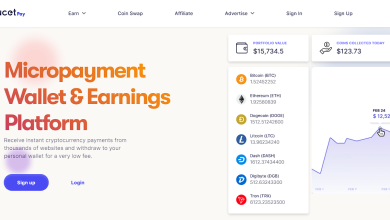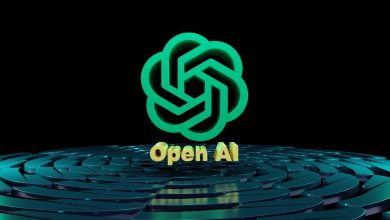The Future of Blockchain: Where Are We Going?
The Future of Blockchain: Where Are We Going?

The Future of Blockchain: Where Are We Going?
As we stand at the threshold of a new decade, a pressing question arises: What does the future hold for blockchain technology? With nearly a quarter of Americans showing interest in learning about cryptocurrencies and decentralized technology, it’s clear that this innovation is gaining traction.

The current landscape of blockchain is rapidly evolving, with its potential applications extending far beyond digital currency. As this technology continues to mature, it’s poised to revolutionize various sectors, from finance to supply chain management.
Key Takeaways
- The growing interest in blockchain technology is driven by its potential to transform multiple industries.
- Decentralized technology is at the forefront of innovation, offering secure and transparent solutions.
- The future of blockchain holds significant promise for advancements in various sectors.
- Understanding blockchain technology is becoming increasingly important for individuals and businesses alike.
- The evolution of blockchain is expected to lead to new and unforeseen applications.
The Evolution of Blockchain Technology
The evolution of blockchain technology has been marked by considerable advancements, starting with Bitcoin and leading to modern distributed ledger systems. This progression has not only enhanced the security and transparency of transactions but has also expanded the scope of applications beyond digital currency.
From Bitcoin to Modern Distributed Ledger Technology
Blockchain technology originated with Bitcoin, introducing a decentralized, peer-to-peer transaction system. Over time, it has evolved into a broader distributed ledger technology, enabling a wide range of applications, including smart contracts and decentralized finance (DeFi). This evolution has been driven by the need for more sophisticated and flexible blockchain architectures.
Key Components of Blockchain Architecture
The architecture of blockchain technology is founded on several key components that ensure its integrity and functionality. These include:
Consensus Protocols and Algorithms
Consensus protocols, such as Proof of Work (PoW) and Proof of Stake (PoS), are crucial for validating transactions and securing the blockchain network. These algorithms ensure that all nodes on the network agree on the state of the blockchain, preventing fraudulent activities.
Encryption and Security Mechanisms
Encryption plays a vital role in securing blockchain transactions. Advanced cryptographic techniques ensure that data is protected and that transactions are secure and tamper-proof. Additionally, security mechanisms such as multi-signature wallets and hardware security modules (HSMs) further enhance the security of blockchain networks.
Current Blockchain Ecosystem
The blockchain landscape is characterized by a mix of public and private networks, each serving distinct purposes within the digital ledger ecosystem. This diversity is a hallmark of the current blockchain ecosystem.
Public vs. Private Blockchain Networks
Public blockchain networks, such as Bitcoin and Ethereum, are open to anyone and allow for decentralized, permissionless transactions. In contrast, private blockchain networks are restricted to specific users and are often utilized by organizations for internal processes.
The choice between public and private blockchain networks depends on the use case, with public networks offering greater decentralization and private networks providing more control over data access.
Major Platforms: Ethereum, Bitcoin, and Beyond
Ethereum and Bitcoin are among the most prominent blockchain platforms, each with unique capabilities.
Smart Contract Capabilities
Ethereum is renowned for its smart contract capabilities, allowing for the creation of self-executing contracts with the terms of the agreement written directly into code. This feature has enabled a wide range of decentralized applications (dApps) on the Ethereum network.
Transaction Processing Capacity
The transaction processing capacity of blockchain networks varies significantly. For instance, Bitcoin’s network processes around 7 transactions per second, whereas Ethereum’s network can handle about 30 transactions per second. Scalability solutions are being developed to enhance these capacities.
Blockchain Technology Applications Transforming Industries
Industries are being reshaped by the innovative applications of blockchain technology. This distributed ledger technology is not only enhancing transparency and security but also streamlining processes across various sectors.
Supply Chain Management and Transparency
Supply chain management is one of the areas where blockchain is making a significant impact. By creating a transparent and immutable record of transactions, blockchain helps in tracking the origin, quality, and movement of goods. This not only reduces counterfeiting but also improves trust among stakeholders.
| Benefits | Description |
|---|---|
| Enhanced Transparency | All transactions are recorded on a public ledger, making it easier to track goods. |
| Reduced Counterfeiting | Immutable records prevent the alteration of transaction history. |
| Increased Trust | Stakeholders can trust the system due to its transparency and security. |
Digital Identity and Data Ownership
Blockchain is also being used to create digital identities, giving individuals control over their personal data. This application ensures that data is secure and that individuals have the ability to decide who can access their information.
Intellectual Property and Content Authentication
The use of blockchain for intellectual property protection is another significant application. It helps in authenticating content and proving ownership, thereby reducing piracy and unauthorized use.
The Rise of Decentralized Finance (DeFi)
Decentralized Finance (DeFi) has emerged as a significant disruptor in the financial industry, offering a new paradigm for financial services that is decentralized, transparent, and accessible to anyone with an internet connection.
The DeFi ecosystem is built on blockchain technology, enabling the creation of decentralized applications (dApps) that can facilitate a wide range of financial activities without the need for traditional intermediaries like banks.
Disrupting Traditional Banking Systems
DeFi is disrupting traditional banking systems by providing an alternative to conventional financial services. This disruption is characterized by the use of smart contracts and decentralized networks, which reduce the need for intermediaries and increase the efficiency of financial transactions.
Lending and Borrowing Without Intermediaries
One of the key features of DeFi is the ability to facilitate lending and borrowing without intermediaries. This is achieved through decentralized lending protocols that allow individuals to lend their crypto assets and earn interest, while borrowers can access loans by providing collateral.
Decentralized Exchanges and Liquidity Pools
Decentralized exchanges (DEXs) and liquidity pools are critical components of the DeFi ecosystem. DEXs enable the trading of crypto assets in a decentralized manner, while liquidity pools provide the necessary liquidity for these exchanges to function efficiently.
The rise of DeFi is transforming the financial landscape, offering new opportunities for financial inclusion and innovation. As the DeFi ecosystem continues to evolve, it is likely to have a profound impact on traditional financial systems.
Blockchain Infrastructure Challenges and Solutions
The increasing demand for blockchain technology has highlighted the need for robust infrastructure solutions to address scalability and interoperability issues. As the blockchain ecosystem continues to grow, it’s becoming clear that the current infrastructure faces significant challenges that need to be overcome to ensure widespread adoption and usability.
Scalability: Layer2 Solutions and Sharding
One of the primary challenges facing blockchain infrastructure is scalability. The current capacity of many blockchain networks is limited, leading to congestion and high transaction fees. To address this, Layer2 solutions have emerged, such as Optimistic Rollups and zk-Rollups, which process transactions off the main chain before bundling them together, thereby reducing the load on the network. Another promising approach is sharding, which involves dividing the network into smaller, parallel processing units called shards, each capable of processing transactions independently. This significantly increases the overall throughput of the network.
Interoperability Between Blockchain Networks
Interoperability is another critical challenge. With numerous blockchain networks operating in isolation, the inability to communicate and exchange data between them hinders the overall efficiency and usability of the blockchain ecosystem. To tackle this, various solutions are being developed.
Cross-Chain Communication Protocols
Cross-chain communication protocols enable different blockchain networks to exchange information and assets seamlessly. These protocols facilitate a more interconnected blockchain ecosystem, allowing for a broader range of applications and use cases. For instance, protocols like Polkadot and Cosmos are pioneering this space by providing the infrastructure for cross-chain interoperability.
Bridging Technologies
Bridging technologies are also being developed to connect different blockchain networks, enabling the transfer of assets between them. These bridges are crucial for creating a more unified and accessible blockchain environment, allowing users to leverage the strengths of multiple networks.
By addressing scalability and interoperability challenges, the blockchain infrastructure can become more robust, scalable, and interconnected, paving the way for further innovation and adoption.
The Regulatory Landscape for Blockchain Technology
Regulatory frameworks for blockchain technology are being established across different regions. This development is crucial as blockchain continues to mature and expand into various industries.
Current Regulatory Approaches Worldwide
The current regulatory landscape for blockchain is diverse. Different countries are adopting varied approaches to regulate blockchain technology. For instance, some countries are embracing blockchain with clear regulatory guidelines, while others are more cautious.
| Country | Regulatory Approach |
|---|---|
| United States | Multi-agency approach with guidelines from SEC, CFTC, and FinCEN |
| European Union | Comprehensive regulations with a focus on anti-money laundering |
| China | Strict regulations with a focus on state-controlled blockchain development |
Future Regulatory Frameworks and Compliance
As blockchain technology evolves, future regulatory frameworks will likely focus on compliance and blockchain security. Ensuring that regulatory frameworks are adaptable and forward-thinking will be crucial.

The development of clear and consistent regulatory frameworks will be essential for the widespread adoption of blockchain technology. It is expected that future regulations will address issues such as consensus protocol standardization and cross-border compliance.
Blockchain and Environmental Sustainability
Blockchain’s environmental sustainability is now a critical consideration for developers and users alike. As the technology continues to grow, its ecological footprint has become a significant concern. The environmental impact of blockchain is primarily associated with the energy consumption of its underlying consensus mechanisms.
Energy Consumption in Proof-of-Work Systems
Proof-of-work (PoW) systems, used by cryptocurrencies like Bitcoin, require significant computational power to solve complex mathematical puzzles. This process consumes large amounts of energy, contributing to greenhouse gas emissions. The energy consumption of PoW systems has been a subject of controversy, with many calling for more sustainable alternatives.
Eco-Friendly Consensus Mechanisms
In response to the environmental concerns associated with PoW, eco-friendly consensus mechanisms have emerged. One such mechanism is proof-of-stake (PoS), which significantly reduces energy consumption by eliminating the need for complex mathematical computations.
Proof-of-Stake Advantages
PoS offers several advantages over traditional PoW systems. It reduces the energy consumption by up to 99%, making it a more environmentally friendly option. Additionally, PoS promotes a more decentralized network, as it eliminates the need for expensive mining equipment.
Carbon-Neutral Blockchain Initiatives
Several blockchain projects are now focusing on carbon-neutral initiatives. These initiatives involve offsetting carbon emissions by investing in renewable energy projects or purchasing carbon credits. Some blockchain platforms are also exploring the use of renewable energy sources, such as solar or wind power, to energize their operations.
| Consensus Mechanism | Energy Consumption | Environmental Impact |
|---|---|---|
| Proof-of-Work (PoW) | High | Significant greenhouse gas emissions |
| Proof-of-Stake (PoS) | Low | Minimal environmental impact |
| Delegated Proof-of-Stake (DPoS) | Low | More energy-efficient than PoW |
The shift towards eco-friendly consensus mechanisms is a positive step towards reducing the environmental impact of blockchain technology. As the industry continues to evolve, it is likely that we will see even more innovative solutions to the environmental challenges associated with blockchain.
Enterprise Adoption of Blockchain
The adoption of blockchain by enterprises is gaining momentum, driven by its potential to transform business processes. As companies explore the benefits of blockchain technology, various strategies and collaborative efforts are emerging.
Implementation Strategies for Businesses
Enterprises are adopting different implementation strategies for blockchain, including piloting small-scale projects to test the technology, and partnering with blockchain technology companies to leverage their expertise. Effective implementation requires a clear understanding of the business needs and the potential impact of blockchain on existing processes.
Industry Consortiums and Collaborative Networks
Industry consortiums are forming to facilitate collaboration and drive the adoption of blockchain technology. These consortiums enable companies to share knowledge, develop common standards, and work together on blockchain-based projects. For instance, the Enterprise Ethereum Alliance is a prominent example of such a consortium.
“Blockchain is not just a technology, it’s a new way of doing business. It allows for the creation of decentralized networks that can transform industries.”
ROI and Business Value Metrics
To measure the success of blockchain adoption, enterprises need to establish clear ROI and business value metrics. This involves tracking cost savings, efficiency improvements, and revenue growth resulting from blockchain initiatives. By quantifying these benefits, businesses can better understand the value of their blockchain investments.

As enterprises continue to adopt blockchain technology, the focus on measurable outcomes and collaborative efforts will drive further innovation and growth in the industry.
Emerging Blockchain Innovations
Emerging blockchain innovations are transforming the way we think about digital assets and decentralized organizations. The blockchain ecosystem is witnessing a significant shift with the advent of new technologies that are set to revolutionize various aspects of our digital lives.
Non-Fungible Tokens (NFTs) and Digital Ownership
NFTs have gained significant traction, allowing for the creation of unique digital assets that can be bought, sold, and traded. This innovation has opened up new avenues for artists and creators to monetize their work, ensuring digital ownership and provenance.
Decentralized Autonomous Organizations (DAOs)
DAOs represent a new paradigm in organizational structure, enabling decentralized decision-making and community involvement. By leveraging blockchain technology, DAOs provide a transparent and secure framework for managing resources and making collective decisions.
Web3 and the Decentralized Internet
The concept of Web3 signifies a shift towards a more decentralized internet, where users have greater control over their data and identity. This emerging trend promises to redefine the way we interact online, fostering a more decentralized and user-centric digital landscape.
These emerging blockchain innovations are poised to have a profound impact on the future of digital assets, organizational structures, and the internet as a whole. As the technology continues to evolve, we can expect to see even more groundbreaking applications.
Blockchain Security: Protecting the Decentralized Future
The decentralized future of blockchain hinges on its ability to maintain robust security measures. As blockchain technology continues to expand across various industries, the importance of securing these networks cannot be overstated.
Quantum Computing Threats and Countermeasures
One of the significant threats to blockchain security is the advent of quantum computing. Quantum computers have the potential to break the cryptographic algorithms that underpin blockchain technology, compromising the security of the entire network.
To mitigate this risk, researchers are exploring quantum-resistant cryptographic algorithms, such as lattice-based cryptography and hash-based signatures. Implementing these countermeasures will be crucial for the long-term security of blockchain networks.
Advanced Security Protocols and Best Practices
In addition to addressing quantum computing threats, blockchain networks must adopt advanced security protocols and best practices to protect against more conventional attacks.
Multi-Signature Authentication
One such protocol is multi-signature authentication, which requires multiple signatures or approvals before a transaction can be executed. This adds an additional layer of security, making it more difficult for malicious actors to manipulate transactions.
Zero-Knowledge Proofs
Another important security measure is the use of zero-knowledge proofs (ZKPs), which enable the verification of transactions without revealing sensitive information about the parties involved. ZKPs enhance privacy and security, making them a valuable tool in the blockchain security arsenal.
To illustrate the effectiveness of these security measures, consider the following comparison of different blockchain security protocols:
| Security Protocol | Description | Benefits |
|---|---|---|
| Multi-Signature Authentication | Requires multiple signatures for transaction execution | Enhanced security against malicious transactions |
| Zero-Knowledge Proofs | Verifies transactions without revealing sensitive information | Improved privacy and security |
| Quantum-Resistant Cryptography | Uses algorithms resistant to quantum computer attacks | Long-term security against quantum threats |
By adopting these advanced security protocols and best practices, blockchain networks can significantly enhance their security posture and protect against a wide range of threats.
Conclusion: Navigating the Blockchain Future
The future of blockchain technology is rapidly evolving, with various developments and innovations on the horizon. As we’ve explored, blockchain has transformed industries through supply chain management, digital identity, and intellectual property authentication.
Navigating the blockchain future requires understanding its decentralized technology and the ecosystem that supports it. From public and private blockchain networks to decentralized finance (DeFi) and enterprise adoption, the landscape is complex.
As blockchain technology continues to mature, we can expect increased adoption and innovation. The rise of decentralized autonomous organizations (DAOs), non-fungible tokens (NFTs), and Web3 will shape the blockchain future.
To navigate this future, it’s essential to stay informed about the latest developments, regulatory frameworks, and security measures. By doing so, we can unlock the full potential of blockchain technology and create a more decentralized and secure world.
FAQ
What is blockchain technology and how does it work?
Blockchain technology is a decentralized, distributed ledger that records transactions across a network of computers. It uses advanced cryptography and a consensus algorithm to secure and validate transactions, making it a secure and transparent way to conduct transactions.
What is the difference between public and private blockchain networks?
Public blockchain networks, such as Bitcoin and Ethereum, are open to anyone and allow anyone to participate in the network. Private blockchain networks, on the other hand, are restricted to a specific group of users and are often used by enterprises to manage internal processes.
What is DeFi and how is it changing the financial landscape?
DeFi, or decentralized finance, refers to the use of blockchain technology to create decentralized financial systems that allow for lending, borrowing, and trading without intermediaries. DeFi is changing the financial landscape by providing a more accessible, transparent, and secure way to conduct financial transactions.
What are some of the challenges facing blockchain infrastructure?
Some of the challenges facing blockchain infrastructure include scalability, interoperability, and security. Solutions such as layer2 solutions, sharding, and cross-chain communication protocols are being developed to address these challenges.
How is blockchain technology being used in supply chain management?
Blockchain technology is being used in supply chain management to increase transparency, security, and efficiency. It allows for the tracking of goods and materials throughout the supply chain, reducing the risk of counterfeiting and improving inventory management.
What is the environmental impact of blockchain technology?
The environmental impact of blockchain technology is a concern, particularly with regards to energy consumption in proof-of-work systems. However, eco-friendly consensus mechanisms such as proof-of-stake and carbon-neutral blockchain initiatives are being developed to mitigate this impact.
What are NFTs and how are they being used?
NFTs, or non-fungible tokens, are unique digital assets that are stored on a blockchain. They are being used to represent digital ownership and scarcity, and are being used in a variety of applications, including art, music, and collectibles.
What is the role of regulation in the development of blockchain technology?
Regulation plays a crucial role in the development of blockchain technology, as it provides a framework for the use of blockchain technology and helps to mitigate risks. Regulatory approaches vary worldwide, and future regulatory frameworks will be important in shaping the development of blockchain technology.
How is blockchain technology being adopted by enterprises?
Enterprises are adopting blockchain technology in a variety of ways, including through the use of private blockchain networks, industry consortiums, and collaborative networks. Implementation strategies, ROI, and business value metrics are all important considerations for enterprises looking to adopt blockchain technology.
What are some of the emerging innovations in blockchain technology?
Some of the emerging innovations in blockchain technology include decentralized autonomous organizations (DAOs), Web3, and decentralized identity. These innovations have the potential to transform a variety of industries and applications.





